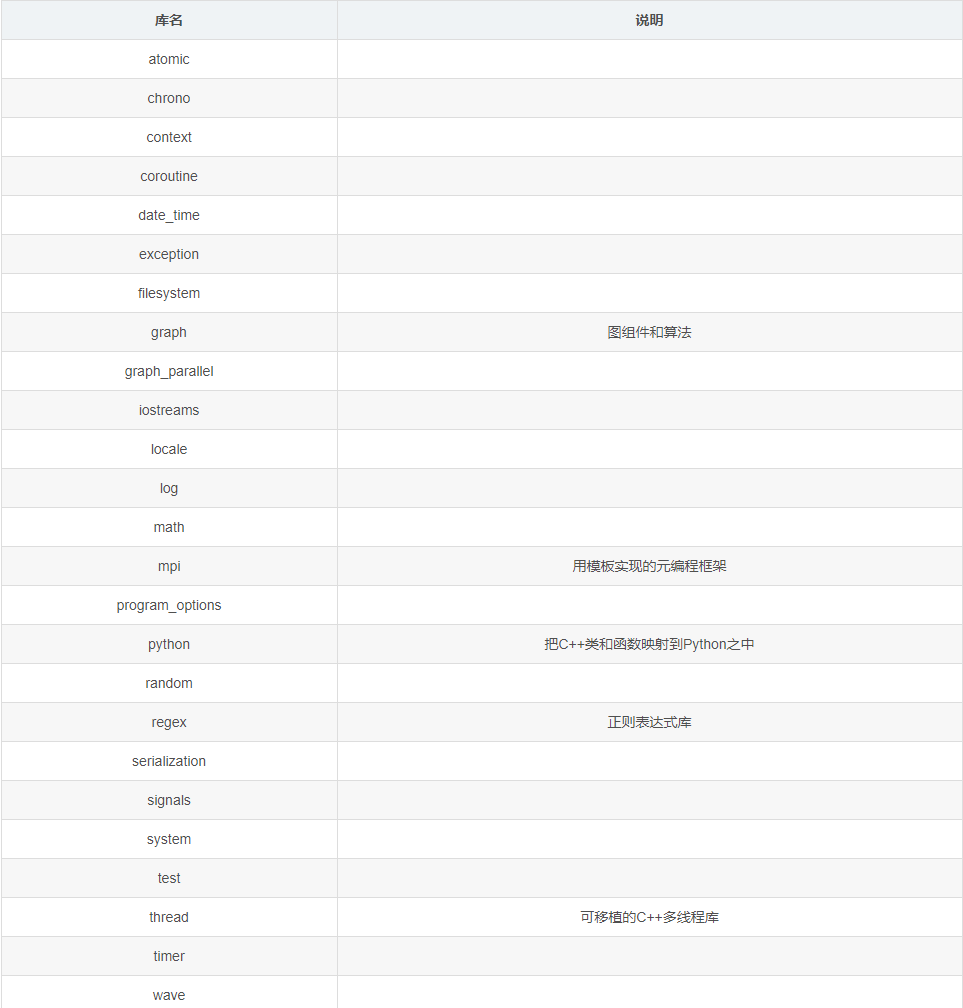1. 下载boost安装包并解压缩
到http://www.boost.org/下载boost的安装包,以boost_1_58_0.tar.gz为例
下载完成后进行解压缩:
tar zxvf boost_1_58_0.tar.gz
2.设置编译器和所选库
先进入解压缩后的目录:
cd boost_1_58_0
然后运行bootstrap.sh脚本并设置相关参数:
./bootstrap.sh --with-libraries=all --with-toolset=gcc
–with-libraries指定编译哪些boost库,all的话就是全部编译,只想编译部分库的话就把库的名称写上,之间用 , 号分隔即可,可指定的库有以下几种:

--with-toolset指定编译时使用哪种编译器,Linux下使用gcc即可,如果系统中安装了多个版本的gcc,在这里可以指定gcc的版本,比如--with-toolset=gcc-4.4
命令执行完成后看到显示如下即为成功:
Building Boost.Build engine with toolset gcc... tools/build/src/engine/bin.linuxx86_64/b2 Detecting Python version... 2.6 Detecting Python root... /usr Unicode/ICU support for Boost.Regex?... not found. Generating Boost.Build configuration in project-config.jam... Bootstrapping is done. To build, run: ./b2 To adjust configuration, edit 'project-config.jam'. Further information: - Command line help: ./b2 --help - Getting started guide: http://www.boost.org/more/getting_started/unix-variants.html - Boost.Build documentation: http://www.boost.org/build/doc/html/index.html
3.编译boost
执行以下命令开始进行boost的编译:
./b2 toolset=gcc
编译的时间大概要10多分钟,耐心等待,结束后会有以下提示:
...failed updating 60 targets... ...skipped 21 targets... ...updated 663 targets...
4.安装boost
最后执行以下命令开始安装boost:
./b2 install --prefix=/usr
–prefix=/usr用来指定boost的安装目录,不加此参数的话默认的头文件在/usr/local/include/boost目录下,库文件在/usr/local/lib/目录下。这里把安装目录指定为–prefix=/usr则boost会直接安装到系统头文件目录和库文件目录下,可以省略配置环境变量。
安装完毕后会有以下提示:
...failed updating 60 targets... ...skipped 21 targets... ...updated 11593 targets...
最后需要注意,如果安装后想马上使用boost库进行编译,还需要执行一下这个命令:
ldconfig
更新一下系统的动态链接库
5.boost使用测试
以boost_thread为例,测试刚安装完的boost库是否能正确使用,测试代码如下:
#include <boost/thread/thread.hpp> //包含boost头文件
#include <iostream>
#include <cstdlib>
using namespace std;
volatile bool isRuning = true;
void func1()
{
static int cnt1 = 0;
while(isRuning)
{
cout << "func1:" << cnt1++ << endl;
sleep(1);
}
}
void func2()
{
static int cnt2 = 0;
while(isRuning)
{
cout << "\tfunc2:" << cnt2++ << endl;
sleep(2);
}
}
int main()
{
boost::thread thread1(&func1);
boost::thread thread2(&func2);
system("read");
isRuning = false;
thread2.join();
thread1.join();
cout << "exit" << endl;
return 0;
}
在编译程序时,需要加入对boost_thread库的引用:
g++ main.cpp -g -o main -lboost_thread
如果boost库的安装位置不是在系统目录下,则还需要在编译时加上-I和-L指定boost头文件和库文件的位置
编译成功后运行程序,利用boost实现的多线程任务正确运行:
func1: func2:00 func1:1 func2:1 func1:2 func1:3 func2:2 func1:4 func1:5 func2:3 func1:6 func1:7 func2:4 func1:8 func1:9 func2:5 func1:10 func1:11 func2:6 func1:12 func1:13 func2:7 func1:14 func1:15 func2:8 func1:16 exit
参考:
boost_1_59_0操作:假如下载到/usr/local/src目录下
进入目录cd /usr/local/src
然后解压tar -xzvf boost_1_59_0.tar.gz
进入boost:cd boost_1_59_0
进行配置:./bootstrap.sh
编译:./b2
安装:./b2 install (修改为sudo ./b2 install)
测试boost是否安装成功:
在linux下任意目录下创建test.cpp
写入如下代码:
#include<iostream>
#include<boost/lexical_cast.hpp>
int main()
{
int a = boost::lexical_cast<int>("123456");
std::cout << a <<std::endl;
return 0;
}
运行命令:
# g++ test.cpp -o test
# ./test
将得到输出结果为:123456,代表boost安装成功。
温馨提示:
Ubuntu安装mysql参考琼杰笔记:【亲测可用】Ubuntu16.04编译安装mysql5.7方法总结
 琼杰笔记
琼杰笔记





评论前必须登录!
注册